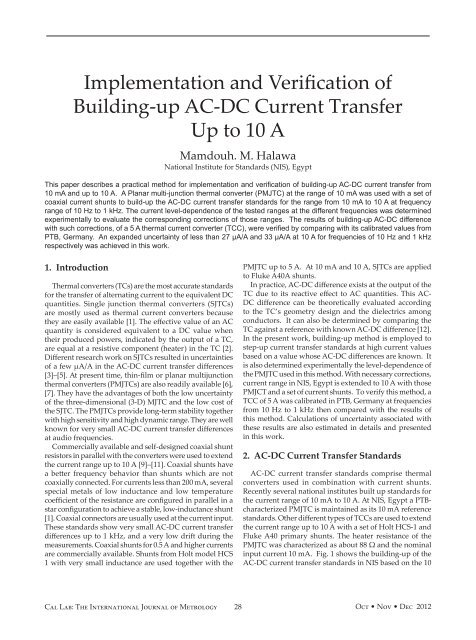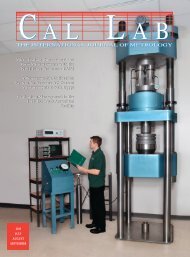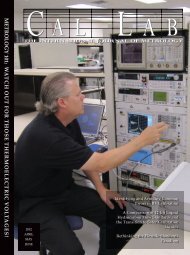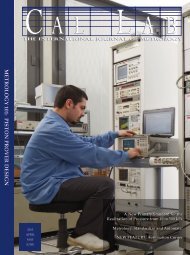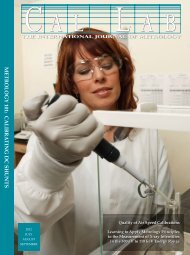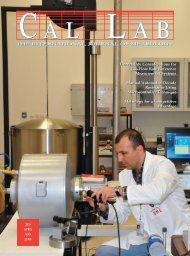Magazine – PDF - Cal Lab Magazine
Magazine – PDF - Cal Lab Magazine
Magazine – PDF - Cal Lab Magazine
Create successful ePaper yourself
Turn your PDF publications into a flip-book with our unique Google optimized e-Paper software.
Implementation and Verification ofBuilding-up AC-DC Current TransferUp to 10 AMamdouh. M. HalawaNational Institute for Standards (NIS), EgyptThis paper describes a practical method for implementation and verification of building-up AC-DC current transfer from10 mA and up to 10 A. A Planar multi-junction thermal converter (PMJTC) at the range of 10 mA was used with a set ofcoaxial current shunts to build-up the AC-DC current transfer standards for the range from 10 mA to 10 A at frequencyrange of 10 Hz to 1 kHz. The current level-dependence of the tested ranges at the different frequencies was determinedexperimentally to evaluate the corresponding corrections of those ranges. The results of building-up AC-DC differencewith such corrections, of a 5 A thermal current converter (TCC), were verified by comparing with its calibrated values fromPTB, Germany. An expanded uncertainty of less than 27 µA/A and 33 µA/A at 10 A for frequencies of 10 Hz and 1 kHzrespectively was achieved in this work.1. IntroductionThermal converters (TCs) are the most accurate standardsfor the transfer of alternating current to the equivalent DCquantities. Single junction thermal converters (SJTCs)are mostly used as thermal current converters becausethey are easily available [1]. The effective value of an ACquantity is considered equivalent to a DC value whentheir produced powers, indicated by the output of a TC,are equal at a resistive component (heater) in the TC [2].Different research work on SJTCs resulted in uncertaintiesof a few µA/A in the AC-DC current transfer differences[3]<strong>–</strong>[5]. At present time, thin-film or planar multijunctionthermal converters (PMJTCs) are also readily available [6],[7]. They have the advantages of both the low uncertaintyof the three-dimensional (3-D) MJTC and the low cost ofthe SJTC. The PMJTCs provide long-term stability togetherwith high sensitivity and high dynamic range. They are wellknown for very small AC-DC current transfer differencesat audio frequencies.Commercially available and self-designed coaxial shuntresistors in parallel with the converters were used to extendthe current range up to 10 A [9]<strong>–</strong>[11]. Coaxial shunts havea better frequency behavior than shunts which are notcoaxially connected. For currents less than 200 mA, severalspecial metals of low inductance and low temperaturecoefficient of the resistance are configured in parallel in astar configuration to achieve a stable, low-inductance shunt[1]. Coaxial connectors are usually used at the current input.These standards show very small AC-DC current transferdifferences up to 1 kHz, and a very low drift during themeasurements. Coaxial shunts for 0.5 A and higher currentsare commercially available. Shunts from Holt model HCS1 with very small inductance are used together with thePMJTC up to 5 A. At 10 mA and 10 A, SJTCs are appliedto Fluke A40A shunts.In practice, AC-DC difference exists at the output of theTC due to its reactive effect to AC quantities. This AC-DC difference can be theoretically evaluated accordingto the TC’s geometry design and the dielectrics amongconductors. It can also be determined by comparing theTC against a reference with known AC-DC difference [12].In the present work, building-up method is employed tostep-up current transfer standards at high current valuesbased on a value whose AC-DC differences are known. Itis also determined experimentally the level-dependence ofthe PMJTC used in this method. With necessary corrections,current range in NIS, Egypt is extended to 10 A with thosePMJCT and a set of current shunts. To verify this method, aTCC of 5 A was calibrated in PTB, Germany at frequenciesfrom 10 Hz to 1 kHz then compared with the results ofthis method. <strong>Cal</strong>culations of uncertainty associated withthese results are also estimated in details and presentedin this work.2. AC-DC Current Transfer StandardsAC-DC current transfer standards comprise thermalconverters used in combination with current shunts.Recently several national institutes built up standards forthe current range of 10 mA to 10 A. At NIS, Egypt a PTBcharacterizedPMJTC is maintained as its 10 mA referencestandards. Other different types of TCCs are used to extendthe current range up to 10 A with a set of Holt HCS-1 andFluke A40 primary shunts. The heater resistance of thePMJTC was characterized as about 88 Ω and the nominalinput current 10 mA. Fig. 1 shows the building-up of theAC-DC current transfer standards in NIS based on the 10<strong>Cal</strong> <strong>Lab</strong>: The International Journal of Metrology28 Oct • Nov • Dec 2012


